
Dino Martens Art Glass Vase with Spiral Motif, c.1950s
Dino Martens (Italian, 1894-1970), Art glass vase, for Aureliano Toso Mezza Filigrana, c.1950s, decorated with spiral motif, in tones of black white and gilt, standing on a slightly raised circular foot, height 25 cm

Barovier and Toso Murano Art Glass Vase, Swirling Lines
Barovier and Toso Murano Art glass vase, of baluster form with flared rim, decorated with a swirling lines in blue and purple translucent tones, etched signature to base, height 19.5 cm and diameter 21.5 cm

Enamelled and Gilt Glass Revival, C1900, Venice, Italy
A revival enamelled and gilt glass, C1900, Probably Francesco Toso Borella, Pauly & C. (Compagnia Venezia Murano), Venice, Italy 1900s, after a Renaissance model, enamelled and gilded clear glass. 13.7 cm high

Opalescent White and Red Murano Glass Cornucopia Vase, 10cm
Barovier & Toso Murano glass cornucopia vase in opalescent white and red, 10 cm high, 28 cm wide

Pink and clear glass vase by Barovier & Toso, 24.5cm
Barovier & Toso Murano glass vase with bubble inclusions in pink and clear glass, 24.5 cm high

Ercole Barovier 'Efeso' Murano Smoke Bubble Vase, c.1964
An impressive Ercole Barovier, Barovier & Torso, Italy 'Efeso' Murano smoke bubble vase, c.1964, artist signature to base, height 31 cm,

Dino Martens Murano Glass Vase for Aureliano Toso, c. 1950s
Attributed to Dino Martens a Murano glass vase for Aureliano Toso, Mezza filigrana glass of ovoid form with foot. Italy, c 1950s, 19 cm high, 20 cm deep
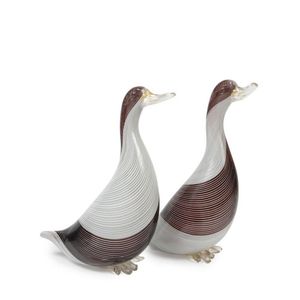
Vintage Murano Glass Duck Figurines, 1950s/60s, Mezza Filigrana Decor
A pair of vintage Murano glass duck figurines, 1950s/60s, in a white and aubergine mezza filigrana decor, with aventurine inclusions to the beak and feet, metallic label underside, I & E.D, otherwise unmarked, but in the manner of Dino Martens, Aureliano…

Barovier & Toso Murano Glass Leaf Dishes with Gold Inclusions
Barovier & Toso pair of leaf shaped Murano glass dishes with aventurine gold inclusions, 7.5 cm wide each

Fratelli Toso Murano Glass Console Bowl, 16.6 cm x 66 cm
Fratelli Toso Murano glass consol bowl, 16.6 cm high, 66 cm wide
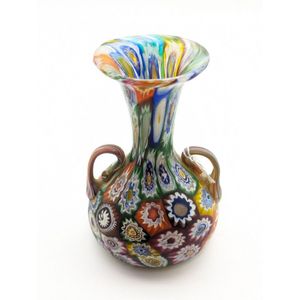
Fratelli Toso Murano Glass Millefiori Cane Satin Vase 13cm
Murano glass vase, Fratelli Toso millefiori cane satin glass twin handle vase 13 cm

Vintage Murano Glass Apple by Barovier & Toso, 1960s Italy
A Murano glass apple by Barovier & Toso, 1960s, Italy. Height 10.5 cm, width 11 cm, depth 10 cm

1960s Murano Glass Vase by Barovier and Toso, Venice Italy
A 1960s Murano glass vase by Barovier and Toso, Murano, Venice, Italy. Height 17 cm, width 15 cm, depth 11 cm

Murano Glass Bird Figure by Ercole Barovier, 9cm
Murano Efeso glass figure of a bird, in the style of Ercole Barovier, depicted with puffed out chest, unsigned, height 9 cm and length 14.5 cm

Barovier and Toso Neomurrino Vase with Original Box and Label
Barovier and Toso, 'Neomurrino' Vase, blown glass, signed, original Murano label to base, together with original box, 22.5 x 21 x 21 cm

Barovier & Toso Murano Cranberry Glass Bowl with Gold Inclusions
Barovier & Toso Murano cranberry glass bowl with gold inclusions, circa 1950s, 12 cm high, 30 cm wide

1950's Oro Murano Glass Baskets by Ercole Barovier for Barovier & Toso
Ercole Barovier pair of Oro Murano glass baskets for Barovier & Toso, circa 1950's, 19 cm high, 21 cm wide

Dino Martens Murano Fasce Bianco Nero Bowl, 1954, 8x21.5cm
Dino Martens Murano Fasce Bianco Nero bowl for Aureliano Toso, circa 1954, 8 cm high, 21.5 cm wide

Dino Martens Murano Fasce Bianco Nero Vase, Circa 1954
Dino Martens Murano Fasce Bianco Nero vase for Aureliano Toso, circa 1954, bearing remains of original paper label, 40.5 cm high

Barovier Pink to Clear Gradient Vase with Gold Flecks
Barovier vase, pink to clear gradient with gold fleck inclusions, Italy, c 1960s, 27 cm high, 27 cm wide, 13 cm deep

Barovier Cobalt Blue Chalice with Religious Scenes
Venetian Barovier chalice, c. 1950, cobalt blue glass, the bell shaped bowl decorated with religious scenes, height 18.5 cm

Pair of Blue Murano Glass Urns, Barovier & Toso (1950s)
Barovier & Tosso pair of blue Murano glass lidded urns, circa 1950s, 30 cm high

Murano Glass Net Bowl by Barovier & Toso
Barovier & Toso (attributed) Murano glass net bowl, 16 cm high, 27 cm wide

Murano Glass Decanter by Barovier & Toso
Barovier & Toso Tartaruga Murano glass decanter, 21 cm high
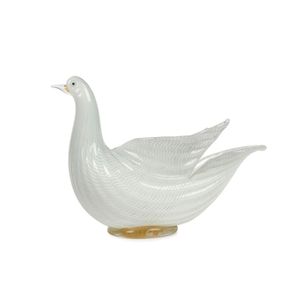
Filigree Murano Glass Bird Bowl by Dino Martens
Dino Martens half filigree Murano glass bird bowl for Aureliano Toso, (model 6073), circa 1960s, 15 cm high, 21 cm long

Stefano Toso Murano Glass Eye Sculpture
A Murano glass sculpture, 'The Eye' created by Stefano Toso, signed to the base and with certificate of authenticity. 36 x 33 cm.

Swirled Barovier & Toso Art Glass Vase (18cm)
Barovier & Toso art glass vase, of tapering form, with a swirled blue, green and gold fleck, signed to base, height 18 cm

Sommerso Vase by Dino Martens & Aureliano Toso
Dino Martens (Italian, 1894-1970), sommerso vase, executed by Aureliano Toso, hand blown clear, orange and turquoise glass, retains Aureliano Toso label, height 28 cm. Provenance: Private Collection, Sydney
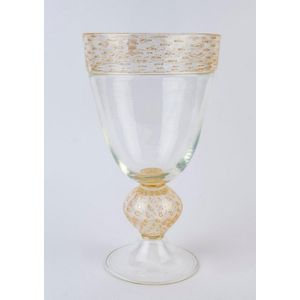
Murano Glass Vase with Aventurine and Bolle Inclusions
Barovier & Toso goblet style Murano glass vase with aventurine and bolle inclusions, 42.5 cm high

Dino Martens Oriente Glass Vase, 31cm
Dino Martens design Oriente glass vase, late 20th century, originally designed in the 1950s for Aureliano Toso, 31 cm high

Dino Martens Oriente Glass Vase, 24cm
Dino Martens design Oriente glass vase, late 20th century, originally designed in the 1950s for Aureliano Toso, 24 cm high

Italian Pastel Mop Glass Jugs Pair, 1960s
Fratelli Toso pair of Italian pastel 'Mop' glass jugs, circa 1960s, pencil inscription '6/6 pair', 23 cm high
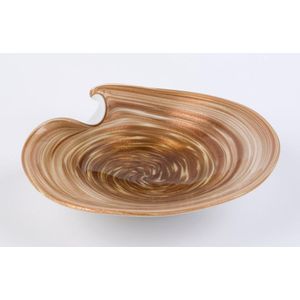
Aventurine Murano Glass Bowl with Milk Glass Back
Fratelli Toso Murano glass bowl with aventurine inclusions and milk glass back, circa 1960, 24 cm wide

Aventurina Murano Glass Bowl, 1960
Barovier & Toso (attributed) Murano glass bowl with aventurina inclusions, circa 1960, 6 cm high, 14 cm wide

Green Murano Glass Vase with Bolle Inclusions (35cm)
Barovier & Toso green Murano glass vase with bolle inclusions, 35 cm high

Pink Opalino Murano Glass Clam Shell Bowl, 1950
Fratelli Toso pink opalino Murano glass clam shell bowl, circa 1950, 23.5 cm high, 35 cm wide

Candy Cane Latticino Bowl by Murano Fratelli Toso
Murano Fratelli Toso bowl, decorated with candy cane, red and white latticino

Multicolour Murano Glass Bowl by Fratelli Toso
Murano glass bowl, Venetian latticino and multicolour cane dish attributed to Fratelli Toso

Gold and Blue Murano Glass Vase
A Barovier & Toso glass vase, Murano, second half 20th century, the tapering gold splashed form in tones of pale yellow and blue, 26 cm high

Polychrome Enamelled Glass Bowl by Vittorio Zecchin
A S.A.L.I.R. polychrome enamelled glass bowl by Vittorio Zecchin, Italian, circa 1938, painted and decorated with leafy stems, incised S.A.L.I.R. To the base, 15 cm diameter, 11.5 cm high. Provenance: Sotheby's Melbourne, 22 - 23 November auction, 2006,…
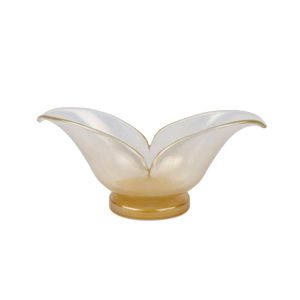
Aventurine Murano Glass Bowl by Barovier & Toso
Ercole Barovier Evanscenti Murano glass bowl with aventurine inclusions, made for Barovier & Toso, circa 1950, 13 cm high, 30 cm wide

1950 Barovier & Toso Murano Glass Candelabra - 29cm
Barovier & Toso Murano glass candelabra, circa 1950, a??29 cm high, 25 cm wide

Green Murano Glass Vase by Barovier & Toso (1950s)
Barovier & Toso green Murano glass vase, circa 1950s, 31 cm high, 29 cm wide

Fratelli Toso Italian Glass: 1854-1980
Glass reference Fratelli Toso Italian glass 1854-1980, Schiffer 2004

Barovier & Tose Murano Tortoiseshell Glass Vase
A Murano art glass vase by Barovier and Tose, straight sided and decorated with a 'Tortoiseshell' pattern, signed to base, 20 cm high

Fratelli Toso Murano Glass Bowl with Spiral Decoration
Attr. Fratelli Toso (1884-1979) a Murano glass bowl; the ogee shaped black glass bowl internally decorated with a spiral of orange, red and copper glass, paper label to base. Height 8.9 cm, diameter 24.1 cm
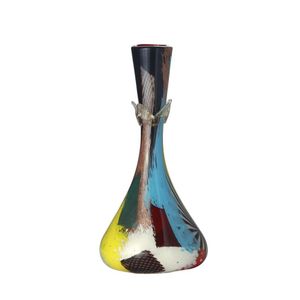
Dino Martens Murano Glass Vase with Inclusions and Petals
Dino Martens (1894-1970) a Vetro Oriente Murano glass vase; circa 1950, the bottle with a band of applied glass petals around the elongated neck, with copper glass and polychrome inclusions including a large star murine, manufactured by Vetreria Aureliano…

Dino Martens Oriente Murano Glass Vase Engraved Tribute
Dino Martens design, Oriente, Murano glass vase, engraved, Omaggio a. Dino Martens + Aldo polo, a. Bon, . Aldo bon was a master glass blower who executed designs for Dino Martens at Aureliano Toso. His Son Bruno bon later became director of Aureliano Toso…
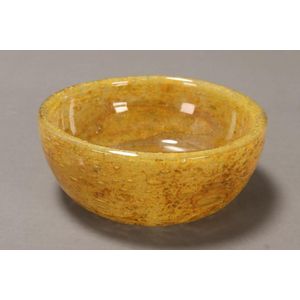
Mustard Glass Bowl by Barovier & Toso
Barovier and Toso glass bowl, of circular form, in mottled mustard coloured glass, original paper label to base, diameter 11 cm

Murano Latticino Glass Vase by Barovier & Toso
A Murano Latticino glass vase by Barovier & Toso, of cylindrical fluted form, internally decorated with geometric designs, etched 'Barovier & Toso Murano' to base, height 23 cm

Pink Alabastro Glass Vase from Fratelli Toso Murano, Italy
Fratelli Toso Murano vase, pink alabastro glass, Italy, c 1950s, 44 cm high, 14 cm deep

Anzolo Fuga Murano Glass Bandiere Vase, 46 cm
A large 'Bandiere' vase by Anzolo Fuga, Murano, 46 cm high. Other Notes: for a similar illustrated example see Rosa Barovier Mentasti, 'Anzola Fuga, Murano glass artist, designs for A.V.E.M.', p. 73.

Gold Inclusions Candelabra by Barovier & Toso
Barovier & Toso Murano glass candelabra with aventurine gold inclusions, circa 1950, 24 cm high, 25 cm wide

Spina Murano Glass Vase by Barovier & Toso
Barovier & Toso A Spina Murano glass vase by Ercole Barovier, circa 1957, engraved Barovier & Toso, Murano, 26 cm high, 21 cm wide

1962 Barovier & Toso Murano Glass Vase, 34cm
Barovier & Toso Argo Murano glass vase, circa 1962, 34 cm high

Opalescent Glass Pendant with Floral Details
A Murano opalescent glass pendant, by Barovier & Toso, circa 1940, the conical shade crafted in rippled opalescent glass with applique glass leaf and floral details with gold foil inclusions, approximately 105 cm long

Tricolor Sommerso Fish Sculpture by Barovier
Barovier (Italian) fish sculpture clear, pink and blue sommerso glass

Italian Glass: A Century of Artistic Brilliance
Italian Glass, 'Glas Glass Verre Vetri I 1950-1960' by Waltraud Neuwirth, 'Venetian Glass The Nancy Olnick & Giorgio Spanu Collection', 'Il Vetro Di Murano Alle Biennali 1895-1972' by Leonardo Arte, 'Venetian Glass 1890-1990' by Rosa Barovier Mentas

1920s Fratelli Toso Millefiori Murano Glass Jug, 20cm High
Fratelli Toso, millefiori Murano glass jug, circa 1920s, 20 cm high

Barovier Murrine Glass Bowl, 1950s
Barovier, murrine Murano glass bowl, circa 1950's, 10.5 cm high, 24 cm wide

Barovier & Toso Murano Glass Vase, 1950s, 10cm
Barovier, & Toso, Murano glass vase, circa 1950's, 10 cm high

Barovier & Toso Murano Glass Bowl
Ercole Barovier, Oro Azzurro Murano glass bowl, circa 1950, original label 'Barovier & Toso, Murano', 7 cm high, 17 cm wide
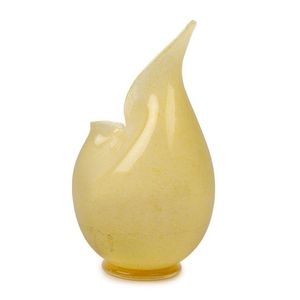
Evanescenti Murano Glass Vase with Aventurine Inclusions
Ercole Barovier, Evanescenti Murano glass vase with yellow fleck and aventurine gold inclusions, made for Barovier, & Toso, circa 1954, 23 cm high

1950s Oro Murano Glass Vase by Ercole Barovier
Ercole Barovier, Oro Murano glass vase for Barovier, & Toso, circa 1950's, 26.5 cm high

Gold Cordonato Murano Glass Vase by Barovier & Toso
Ercole Barovier, Cordonato Oro Murano glass vase for Barovier, & Toso, circa 1950, with original label 'Barovier & Toso, Murano', 26 cm high

Barovier's Merletto Heavy Glass Vase, 1935
Ercole Barovier, Merletto heavy Murano glass vase for Ferro Toso, Barovier, circa 1935, 27 cm high, 29 cm wide

Errmano Toso Murano Glass Bowl, 1956
Vetreria Fratelli Toso, murrine Murano glass bowl by Errmano Toso, circa 1956, 20 cm high

Errmano Toso Murrine Tall Glass Vase, 1956
Vetreria Fratelli Toso, murrine tall Murano glass vase by Errmano Toso, circa 1956, 44 cm high

Filigree Murano Glass Scallop Shell Bowl by Dino Martens
Dino Martens, Filigree Murano glass scallop shell shaped bowl for Aureliano Toso, circa 1950's, 19 cm wide

1954 Murano Glass Bowl by Dino Martens for Toso
Dino Martens, Murano glass bowl for Aureliano Toso, circa 1954, 21 cm wide

Scalloped Murano Glass Bowl by Dino Martens, 1952
Dino Martens, Oriente Murano glass scalloped shaped bowl for Aureliano Toso, circa 1952, 5.5 cm high, 17 cm wide

Oriente Murano Glass Bowl by Dino Martens
Dino Martens, Oriente Murano glass bowl for Aureliano Toso, circa 1952, 5.5 cm high, 16 cm diameter

Dino Martens Murano Glass Bird Vase
Dino Martens, for Aureliano Toso 'Smergo' Murano glass bird vase, for Aureliano Toso, circa 1959. Ref. Marc Heiremans 'Dino Martens' page 129 and 135. 47.5 cm high

Fasce Bianco Nero Vase by Dino Martens
Dino Martens, Fasce Bianco Nero vase for Aureliano Toso, circa 1954, 12.4 cm high

Dino Martens Murano Glass Vase, 1954
Dino Martens, Fasce Bianco Nero Murano glass vase for Aureliano Toso, circa 1954, 25 cm high

1930s Murano Glass Medusa Vase by Ercole Barovier
Ercole Barovier Murano glass 'Medusa' vase, circa 1930s, 35 cm high
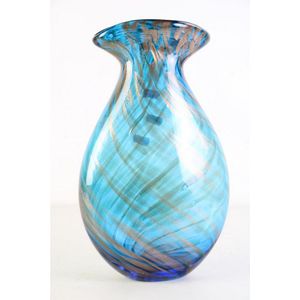
Italian Aventurine Glass Vase - Fratelli Toso?
Vintage Italian Aventurine glass vase, possibly Fratelli Toso, height 35 cm, very minor scratches to base

Turquoise Filigree Bowl by Dino Martens
Dino Martens (Italian, 1894-1970), bowl, c. 1955 executed by Aureliano Toso, internally decorated blown glass, clear with turquoise and white mezza filigrana

Turquoise Filigrana Vase by Dino Martens
Dino Martens (Italian, 1894-1970), vase, c. 1955 executed by Aureliano Toso, internally decorated blown glass, clear with turquoise and white mezza filigrana

Murano Swirl Glass Vessels, Italy c. 1970s
Two Vetreria Fratelli Toso Murano vessels, clear glass with sculptured interior swirls, Italy, c 1970s, largest 20 cm high, 31 cm wide, 11 cm deep

Gold Inlaid Footed Bowl
Attributed to Ercole Barovier (Italian, 1889-1972) footed bowl, c. 1950, clear and white glass, internally decorated with gold leaf inclusions

Mid-Century Venetian Glass Lamp by Ercole Barovier
Venetian glass lamp mid century, designed by Ercole Barovier, made by Murano Firm Barovier e Toso, in Cordonato d'Oro glass, height 47 cm

Golden Cord Vase by Barovier & Toso
Barovier & Toso 'Cordonato D'Oro' vase, Italy, c 1950s, 33 cm high, 18 cm wide, 14 cm deep

Barovier Wedding Cup in Cobalt Blue Glass
Venitian 'Barovier wedding Cup', c. 1950, cobalt blue glass, the wide bellshaped bowl decorated with females bathing, signed 'Sp*', height 20.7 cm, labels: after the orginal, on display at the Palazzo Giustiniani, Museum of glass Art, Venice, Italy

Barovier Wedding Cup in Cobalt Blue Glass
Venitian 'Barovier wedding Cup', c. 1930, cobalt blue glass, the wide bellshaped bowl decorated with a seascape, height 20.5 cm, labels: after the original, on display at the Palazzo Giustiniani, Museum of glass Art, Venice, Italy

Dino Martens Duck Sculpture
Dino Martens (Italian, 1894-1970), duck sculpture, c. 1950, probably executed by Aureliano Toso, internally decorated and applied glass, retains remnant of decal label, height 27 cm
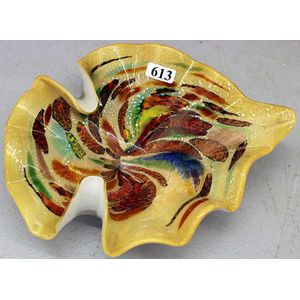
Murano Aventurine Leaf Dish
A Murano cased art glass dish, leaf form with Aventurine 'Tutti Fruitti' / Toso Vetro design. Circa 1950. Length 23 cm.
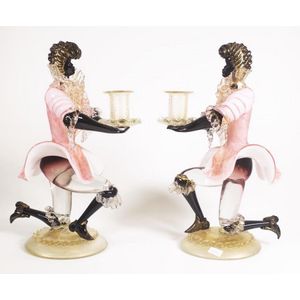
Blackamoor Murano Glass Candlesticks with Pink Costumes
Pair of good Murano glass Blackamoor candlesticks maker: Barovier & Toso, with pink 'foglia d'oro' costumes, with aventurine candleholders and circular bases, height 32 cm

Dino Martens Handkerchief Vase by Aureliano Toso
Dino Martens (Italian, 1894-1970), handkerchief vase, produced by Aureliano Toso, internally decorated and applied glass, unsigned, height 20 cm width 30 cm

Dino Martens Pitcher for Aureliano Toso, c. 1950
Dino Martens (Italian, 1894-1970), Pitcher, c. 1950, for Aureliano Toso, applied and internally decorated blown glass, clear with green and white mezza filigrana, handle with gold inclusions, height 21.5 cm. Provenance: Private Collection, NSW
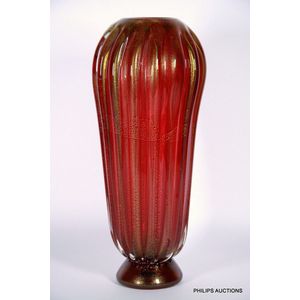
Red and Gold Murano Vase with Inclusions and Ribbed Design
A large red and gold Murano vase, after 2007, Vetruria Murano design, a tapering ribbed blood red vase upon a small waisted base flushed with gold inclusions emulating Barovier & Toso's 'Cordonato D'oro' range; with clear plastic Murano design label to…

Barovia & Toso Murano Bottle Vases, c. 1960s
In the style of Barovia & Toso three cased bottle vases, Murano, Itay, c 1960s, 35 cm high, 10 cm deep

Murano Art Glass Plaque: La Bottega Del Caffe
Marco Toso Borella Murano art glass plaque, titled verso 'La Bottega Del Caffe', hand painted art glass plaque, initialed MTB. Shadow box: 46.5 cm x 43.5 cm frame approx.

Italian Brass and Glass Wall Sconce
After Barovier & Toso, Italian Wall Sconce, c. 1950, brass and textured glass, height 33 cm
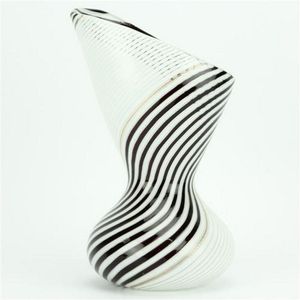
Filigrana Aventurine Glass Vase by Dino Martens
Murano Dino Martens for Aureliano Toso 'Bianca Nera' art glass vase decorated in white filigrana with two ribbons of aventurine dividing the colours. Condition good, minor wear to the base. Height 20 cm

 Loading more...
Loading more...